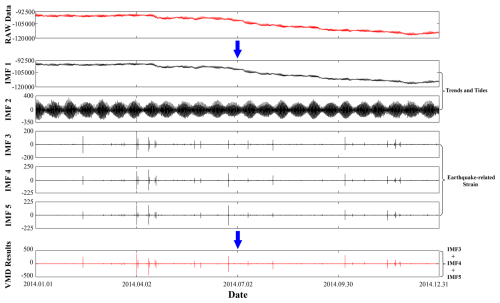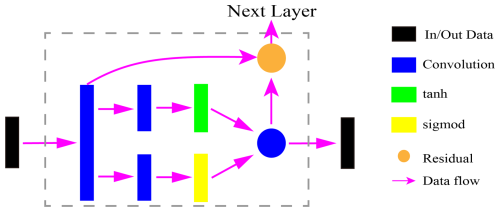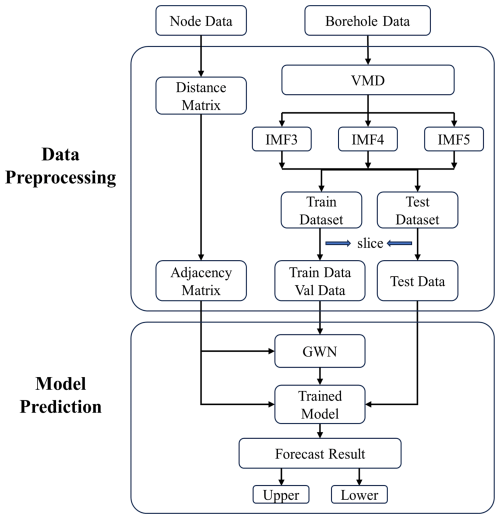the Creative Commons Attribution 4.0 License.
the Creative Commons Attribution 4.0 License.
Analysis of borehole strain anomalies before the 2017 Jiuzhaigou Ms 7.0 earthquake based on a graph neural network
Chenyang Li
Changfeng Qin
Jie Zhang
Yu Duan
Chengquan Chi
On 8 August 2017, a strong earthquake of magnitude 7.0 occurred in Jiuzhaigou, Sichuan Province, China. To assess pre-earthquake anomalies, we utilized variational mode decomposition to preprocess borehole strain observation data and combined them with a graph WaveNet neural network model to process data from multiple stations. We obtained 1-year data from four stations near the epicenter as the training dataset and data from 1 January to 10 August 2017 as the test dataset. For the prediction results of the variational mode decomposition–graph WaveNet model, the anomalous days were extracted using statistical methods, and the results of anomalous-day accumulation at multiple stations showed that an increase in the number of anomalous days occurred 15–32 d before the earthquake. The acceleration effect of anomalous accumulation was most obvious 20 d before the earthquake, and an increase in the number of anomalous days also occurred in the 1 to 3 d post-earthquake. We tentatively deduce that the pre-earthquake anomalies are caused by the diffusion of strain energy near the epicenter during the accumulation process, which can be used as a signal of pre-seismic anomalies, whereas the post-earthquake anomalies are caused by the frequent occurrence of aftershocks.
- Article
(4873 KB) - Full-text XML
- BibTeX
- EndNote
Earthquakes are vibrations caused by the rapid release of energy from the Earth's crust, causing deformation. They damage the ground, buildings, transport, and other facilities and can lead to secondary disasters such as volcanic eruptions (Nishimura, 2017), tsunamis, and epidemics, which can cause serious harm to human society and the economy. Therefore, studying earthquake precursors is crucial. Researchers have explored possible anomalies before earthquakes in many fields, including strain (Yu et al., 2021; Chi et al., 2019; Zhu et al., 2018), geomagnetism (Zhu et al., 2021; Yao et al., 2022), geothermics (Zhang and Li, 2023; Hafeez et al., 2022), subsurface fluids (Liu et al., 2014; Yadav et al., 2023), and the ionosphere (Shi et al., 2023; Akhoondzadeh et al., 2022).
Strain, as the most direct physical quantity indicating the transition from elastic deformation to rock damage and destabilization due to stress changes, is more likely to exhibit anomalous changes in rocks before an earthquake (Yue et al., 2020). Borehole observation can capture subtle phenomena in the process of seismicity in a timely manner, and borehole strain observation data can reflect the stress and strain changes in rocks. Obtaining such data involves installing an instrument probe in the soil or rock layer, tens or even hundreds of meters underground. Scholars worldwide have accumulated numerous research results on extracting and identifying pre-seismic anomalous signals using borehole strain observation data. Shu and Zhang (1997) first used capacitive borehole strainmeters to successfully predict a magnitude 6.4 earthquake in Wushi County, and Kitagawa et al. (2006) observed a change in crustal strain before the 2004 Sumatra–Andaman earthquake (magnitude 9.0). Chi (2013) studied the tidal distortion strain anomalies before the 2008 Wenchuan and 2013 Lushan earthquakes and preliminarily determined that these anomalies were the strain precursors of the two strong earthquakes. Qiu et al. (2015) analyzed significant anomalous changes in the days before the Lushan earthquake and concluded that the anomalies recorded by borehole strainmeters were related to the genesis of the earthquake.
There are many processing methods for seismic signals, including many common and effective methods. Ma et al. (2011) used digital filtering techniques to study the body strain and barometric pressure data from Yixian Station from 2002 to 2007, removed the long-period components in the raw data, and analyzed the high-frequency spectral characteristics of the body strain with the fast Fourier transform method. Deng et al. (2015) used the Fourier transform method to generate a spectral decomposition method for high-resolution seismic images based on the frequency–amplitude spectrum of the signal, which was applied in the extraction of weak signals from deep-reflection earthquakes. Zhang (2018) used the continuous wavelet transform method to analyze the time–frequency analysis of the borehole strain data from Guza Station, extracted the strain anomalies in the time–frequency spectrum, and analyzed the correlation between the strain anomalies and the seismic precursor anomalies. The empirical mode decomposition (EMD) method can smooth the non-smooth signals to obtain a series of components with different frequencies (intrinsic modal function, IMF), by which the non-smooth, non-linear signals can be decomposed into smooth signals with different timescales (Lei et al., 2022). Yang et al. (2014) used the Hilbert–Huang transform (HHT) method to analyze the marginal spectral features of the unexplained large tensile jumps recorded in the borehole body strain at the Qianling seismic station in February–June 2012 and judged that the main cause of this strain anomaly was a power supply problem. However, EMD suffers from the mode aliasing phenomenon, the endpoint effect, and difficulty in determining the stopping condition. Compared with the recursive decomposition mode of EMD, variational mode decomposition (VMD) transforms the signal decomposition into a variational decomposition mode, which essentially comprises a set of multiple adaptive Wiener filters, and VMD can realize the adaptive segmentation of each component in the frequency domain of the signal, which can effectively overcome the mode aliasing phenomenon generated by EMD decomposition and has a stronger noise robustness and a weaker end-point effect than EMD. Therefore, the VMD method is suitable for analyzing non-linear, non-smooth signals such as steps, jumps, and burr. The VMD method has been widely used in fields such as geoscience, and the results of processing seismic signals are significantly better than the other signal processing methods mentioned above (Zhang et al., 2022; Rao et al., 2024; Liu et al., 2016b; Li et al., 2018).
Most studies on borehole strain data are limited to analyzing data from individual stations, ignoring the spatial relationships between stations in a seismic network. Most seismic analysis methods require knowledge of the geographic locations constituting the seismic network (van den Ende and Ampuero, 2020). Graph neural networks (GNNs) have become a popular deep-learning method with fast computing and strong feature extraction abilities. For a graph data structure composed of a seismic station network, a GNN can be used to mine additional hidden information between nodes. For example, in a traffic flow prediction task, nodes usually represent traffic monitoring points and node features can be divided into explicit and implicit features. Explicit features are data that can be directly observed, e.g., the speed of vehicles passing through a node, while implicit features are information indirectly obtained through model learning or data mining methods, e.g., the congestion pattern of a specific node at different times of the day found by analyzing historical and real-time data (Chen et al., 2023). At present, the application of GNNs has achieved good results in many fields, but its application in the field of Earth science is still relatively small (Lin, 2022; Bilal et al., 2022; Liu, 2022). Subsequently, the method holds great potential for application in the data analysis of seismic networks.
In our case study, a method based on a variational mode decomposition–graph WaveNet (VMD–GWN) model was proposed to predict borehole strain data from multiple stations, and the pre-seismic anomalies of the Jiuzhaigou earthquake were extracted based on the prediction intervals. The VMD method can automatically extract the local features of the signal, avoiding the problem of manually selecting the basis function in the traditional decomposition method and using the VMD to preprocess the measured borehole strain data. For the graphical data structure consisting of a network of seismic stations, we take the monitoring stations at different locations as nodes and the data directly observed by each station as explicit features. By analyzing the historical observation data of the stations and the distances between the stations, we can mine the implicit features such as the response patterns of different stations in different seismic events or the correlation between stations. The graph WaveNet model considers the characteristics of the nodes themselves as well as the spatial relationships between different nodes, uses the GWN to jointly analyze the borehole strain data from the seismic networks near the epicenter of Jiuzhaigou, and obtains the prediction results from different stations. Based on the prediction results, pre-earthquake anomalous days were extracted, the anomalous extraction results were fitted using the S-shape function, and the anomalous days were extracted and the S-shape fitting results analyzed. The rest of the paper is organized as follows: in Sect. 2, the Jiuzhaigou earthquake is presented. In Sect. 3, borehole data, station data, and the division of the dataset are presented. Section 4 presents the methodology and the model used in this study. Section 5 presents the parameter selection, prediction results, anomaly extraction results, and discussion. Finally, the conclusions are presented in Sect. 6.
The Sichuan Basin is at the junction of the Eurasian Plate and the Indian Plate and is influenced by the neighboring mountain ranges and plateaus, forming several fracture zones, and its unique geographic location has led to frequent earthquakes within Sichuan (Zhang, 2023). On 8 August 2017, a magnitude 7.0 earthquake occurred in Sichuan, with the epicenter located in Jiuzhaigou County, Aba Prefecture, Sichuan Province, at 33.2° N, 103.82° E, with a depth of 20 km. On 14 August 2017, it was determined that 25 people had been killed, 525 people had been injured, 6 people were missing, and 73 671 houses had been damaged (Yi et al., 2017). The Jiuzhaigou earthquake was the third-largest earthquake of recent years in the active tectonic zone along the eastern margin of the Ba Yan Ka La block, the first two being the Wenchuan earthquake (magnitude 8.0) in 2008 and the Lushan earthquake (magnitude 7.0) in 2013. Unlike the latter two earthquakes, the epicenter of the Jiuzhaigou earthquake was located at the confluence of the East Kunlun Fracture Zone of the Ba Yan Ka La block on the Tibetan Plateau, the Minjiang River fracture, the Tazang fracture, and the Huya fracture (Xu et al., 2017). A topographic map of Jiuzhaigou at the epicenter is shown in Fig. 1.
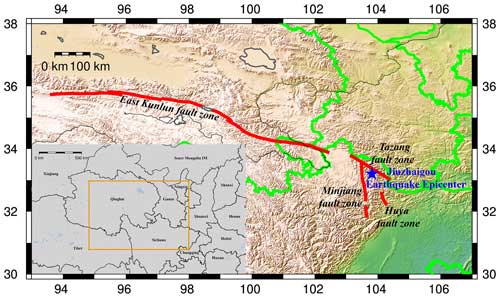
Figure 1Topographic map of the epicenter of Jiuzhaigou earthquake. The blue star indicates the epicenter; the red line indicates the fault zone; the orange boxes in grey areas indicate the study location. This map was generated by GMT software, v. 6.0.0rc5 (https://gmt-china.org/, last access: 15 November 2024).
3.1 Borehole strain data
Multiple recent studies have verified the reliability of sampled data from high-component borehole strainmeters, indicating that four-component borehole strain observations can detect seismic waves (Tang et al., 2023). The YRY-4 four-component borehole strainmeter has the advantages of high sensitivity, a wide observation bandwidth, self-consistent data, and long-term stability. Its working principle is to measure the relative changes between rock apertures using radial displacement sensors and to record the sampled data in minutes (Zhang and Niu, 2013; Lou and Tian, 2022). Four probes mounted on the borehole strainmeters were spaced 45° apart. The measured value of any one element is recorded as S1, which is rotated by 45° in turn, and the remaining three elements are recorded as S2, S3, and S4, respectively. The amount of change in the observed values of the four elements satisfies the following self-consistent equation:
where k is the coefficient that satisfies the self-consistency of the data, and we consider the data to be self-consistent when k≥0.95. The measured values of the four components were converted as follows:
All three substitutions were significant. Among them, S13 and S24 are mutually independent shear strains and Sa is the surface strain (Qiu et al., 2009). Compared with shear strain S13, the surface strain Sa is more representative of the four components measured by the YRY-4 borehole strainmeters, so the data characteristics of surface strain Sa are used in this paper as the object of study.
3.2 Station information
Dobrovolsky et al. (1979) determined the relationship between the magnitude and the radius of influence using the following equation:
where M denotes the magnitude of the earthquake and ρ denotes the radius of influence of magnitude M. According to the above formula, the influence range of the Jiuzhaigou earthquake is approximately 1023 km, and the data from the stations near the epicenter of the Jiuzhaigou earthquake were analyzed. Linxia Station is the closest to the epicenter of the Jiuzhaigou earthquake, with a distance of 272 km, and the distances between the remaining stations and the epicenter are 376 km for Guza Station, 402 km for Haiyuan Station, and 775 km for Gaotai Station, indicating that these stations are capable of receiving the anomalous signals of the Jiuzhaigou earthquake. Therefore, borehole strain data from Linxia, Guza, Haiyuan, and Gaotai stations were selected as the study objects. The latitude, longitude, distance from the epicenter, and rock type of each station were analyzed, and this basic information is listed in Table 1 (Yang et al., 2010; Chen et al., 2024; Wu et al., 2010; Liu et al., 2016a).
The distance between any two stations was calculated from the latitude and longitude of each station, and a distance-based matrix was constructed from the distances between the stations, which were normalized to an adjacency matrix. Figure 2 shows the node distance map comprising the location of the epicenter of Jiuzhaigou and the distances between the stations.
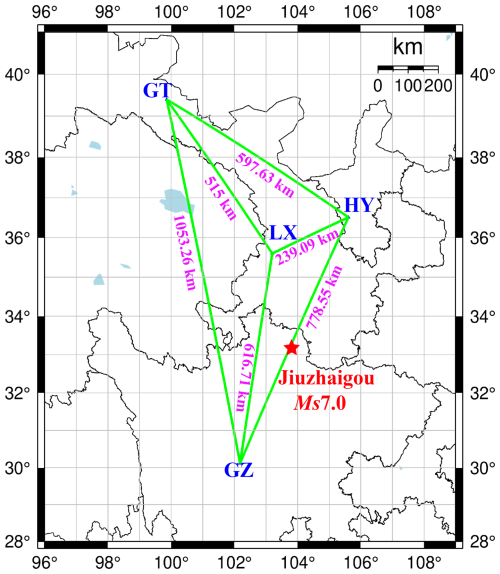
Figure 2Nodal-distance diagram constructed for borehole strain observation stations. The red star represents the epicenter location. LX, GZ, HY, and GT correspond to Linxia Station, Guza Station, Haiyuan Station, and Gaotai Station, respectively. Purple represents the distance between any two stations; the green line represents the graph structure composed of four stations.
3.3 Division of dataset
The borehole strain data used in the study were obtained from the Beijing Seismological Bureau. First, we validated the borehole strain data from each station, and the validation results satisfied self-consistent equations. By performing strain conversion on the four-component data Si from the borehole strainmeters, two shear strains, S13 and S24, and three components of the surface strain Sa were obtained, and the Sa component data were used.
Through the analysis of data from each station, we identified smoother data segments to form the training dataset. Notably, the data from Gaotai and Haiyuan stations in 2013, the data from between 1 October 2015 and 30 September 2016 from Guza Station, and the data from Linxia Station in 2014 exhibited smoother characteristics. The Sa component of 1 year of relatively smooth borehole strain observations at the four stations was used to study the Jiuzhaigou earthquake. The first 75 % of this 1-year dataset was used for training, and the remaining 25 % was used for validation, thus dividing the training and validation sets. As shown in Fig. 3a, the data for the Sa components of the training and validation datasets are given. Since the data from Guza stations are up to 10 August 2017, the Sa components of the borehole strain data from 1 January to 10 August from the four stations were selected for testing (Fig. 3b). The model obtained from the training was based on relatively smooth data. Therefore, the prediction obtained from the test dataset was also relatively smooth, and the anomalies were better highlighted by comparing and analyzing the prediction results with the original data of the test set.
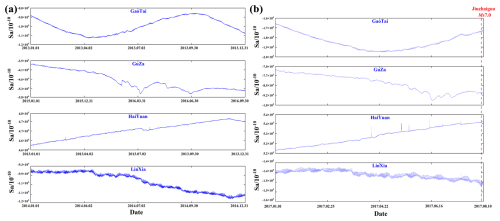
Figure 3Datasets of Sa components for Linxia, Guza, Haiyuan, and Gaotai stations. (a) Sa component data of each station for the training dataset. (b) Sa component data of each station for the test dataset. The dashed red line indicates the time of the Jiuzhaigou earthquake. The date format is yyyy.mm.dd.
Figure 3 shows the raw data of the training set and the test set. Evidently, only the test set data of Haiyuan Station show the phenomenon of a “sudden jump”. Therefore, it was difficult to make an accurate judgment regarding the analysis of earthquakes based on the change patterns of raw data.
4.1 Variational mode decomposition (VMD)
VMD is an adaptive, fully non-recursive approach to modal variational and signal processing that achieves better results when dealing with non-smooth sequence data. It achieves this by decomposing the time-series data into a series of intrinsic modal functions (IMFs) with a finite bandwidth and iteratively searching for the optimal solution of the variational modes (Dragomiretskiy and Zosso, 2014). The principle of the VMD algorithm is to transform the decomposition process into an optimization process, and the constrained variational problem obtained is as follows:
where and are shorthand symbols for all modes and their center frequencies, respectively. ∑K is the sum of all modes. Solving the above equation yields the solution formula for the mode uk as
The equation for solving the center frequency is
The focus of this study was not on the VMD algorithm, which was only used for data preprocessing of the surface strain Sa. For a detailed explanation of the algorithm, refer to Dragomiretskiy and Zosso (2014).
The surface strain Sa data from Linxia Station were selected for VMD processing. The decomposition bandwidth was set to 2000, the number of modes decomposed was five, and the convergence accuracy was 10−7. The decomposition results are shown in Fig. 4. Comparing the decomposition results with the relevant influencing factors, it was found that IMF1 represents the annual trend component and IMF2 represents the tide. The influence of IMF1 and IMF2 on the observed borehole strain data was removed, and the remaining three components were summed to obtain the VMD results.
4.2 Convolutional neural network (CNN)
Convolutional algorithms have been used for images; however, their applications are not limited to images. Information extraction in the time dimension through convolutional operations can process time-series data and effectively solve time-series problems. With the rapid development of deep learning and GPU arithmetic in recent years, researchers have successfully applied convolutional neural networks to time-series prediction tasks, including financial time-series prediction (Solís et al., 2021; Kirisci and Cagcag Yolcu, 2022), wind speed series prediction (Manero et al., 2019; Gan et al., 2021), and hydrological flow forecasting (Barino et al., 2020; Shu et al., 2021).
4.2.1 Temporal convolutional network (TCN)
In a neural network, a “layer” is a basic building block, and each layer contains a set of neurons which accept input data, perform specific computational operations, and then pass the results to the next layer. Different types of layers have specific functions and characteristics, and by combining and configuring different layers, powerful and flexible neural network models can be constructed to achieve a variety of complex tasks. A TCN is an improved form of a CNN that has been shown to significantly outperform baseline recursive architectures in numerous sequence modeling tasks (Gopali et al., 2021; Bai et al., 2018; Abu Bakar et al., 2021). Compared to recursive architectures, TCNs are more suitable for domains with long memories, can be processed in parallel to save time, and consist of modules such as causal and dilation convolutions. Causal convolution is a unidirectional structure that cannot detect future data and is a strict time-constrained model. Moreover, it ensures causal temporal ordering when data are extracted using feature information. When the causal convolution needs to go back for a long time for historical information, the number of convolution layers will need to be high, and problems such as gradient vanishing will occur. Dilation convolution allows partition sampling of the convolution input. Increasing the sensory field by introducing a dilation factor enables a significant reduction in the number of convolution layers while capturing longer temporal dependencies. The relationships among the receptive field, dilation factor, and convolution kernel are as follows:
where n is the number of layers in the convolutional layer; Fn is the sensory field of the nth convolutional layer; k is the size of the convolutional kernel; and d is the size of the dilation factor, which generally increases exponentially by 2 as the number of convolutional layers increases.
4.2.2 Gated TCN
A gating mechanism is an important technique in neural networks, and the core idea behind it is to control the flow of information dynamically so as to efficiently capture and utilize long-dependent information. The gating mechanism controls the flow of information through the design of a “gate”, which is usually a neural network layer with an activation function whose output value is located between 0 and 1, and decides what information should be “remembered” and what information should be “forgotten” by the output value. The introduction of non-linear gating mechanisms into sequence modeling can effectively control information transfer in hierarchical structures (Dauphin et al., 2017; Van Den Oord et al., 2016). The basic structure of the gated TCN is shown in Fig. 5; two gates are introduced after the first convolution and are added to each convolution module of the normal TCN, one of which is used for the convolution of the input to extract features, with tanh as the activation function. The other gate is used to control the processing and outflow of the information, using sigmod to process it to a value between 0 and 1. The gated TCN model is expressed as
where W1 and W2 represent the weight parameters of different convolutions, b1 and b2 represent the corresponding bias terms, ⋅ denotes the convolution operation, and T represents the output of the gated TCN module.
This study was based on borehole strain data that comprise a typical time series, and the temporal features of the borehole strain data were extracted using a gated TCN.
4.3 Graph neural network (GNN)
Traditional deep-learning methods have achieved great success in processing Euclidean spatial data such as speech and images, whereas non-Euclidean spatial data such as social networks (Liang, 2023; Shan et al., 2024) and knowledge graphs (Li et al., 2023; Yin et al., 2024) have performed less satisfactorily when using traditional deep-learning methods. GNNs have broken new ground in many application scenarios for non-Euclidean spatial data by learning graph-structured data and extracting and mining features and patterns (Wu et al., 2020).
4.3.1 Graph convolution network (GCN)
The essence of a GCN is to extract the spatial features of the graph structure and achieve information transfer and feature extraction by performing a convolution operation on the feature vector through the adjacency matrix of the graph. Let the number of nodes in the graph be N and the hidden state dimension of each node be D. The features of these nodes form a matrix of size N×DX. The relationships between individual nodes can be extracted as a relationship matrix of size N×NA. A is the adjacency matrix. In the graph structure, X represents the node features, A represents the edge information, and X and A are the input features of the GCN model. The convolutional layer of the graph is defined as (Kipf and Welling, 2016)
where is the degree matrix of . is an unnormalized matrix, and multiplying it directly by H changes the original feature distribution. , IN is an N-dimensional unit matrix, and adding the unit matrix allows the node's own features to be considered. is a symmetrically normalized matrix; W(l) is the weight matrix for the lth layer; σ is the non-linear activation function; and is the activation matrix of layer l, where H(0)=X, H(L)=Z, and Z is the final feature extracted by the GCN.
4.3.2 Graph WaveNet (GWN)
In this section, the GWN proposed by Wu et al. (2019) is described. The authors introduced graph convolution into the WaveNet model (Van Den Oord et al., 2016), taking into account the spatial relationships between nodes and the characteristics of the node sequence data, and employed it for a traffic prediction task. In our study, the observation stations are used as nodes, and the observation data are used as attributes of the nodes. By connecting different stations as edges and using the distance between stations as an attribute of an edge, a node graph based on multi-station borehole strain data is constituted. The node graph constructed from the distances between borehole strain stations was chosen to be constructed as an unordered graph as the information interaction between the nodes is vague. In the GWN model, each time block is followed by a graph convolution layer that extracts the temporal features of the nodes using a gated TCN and the spatial features of the nodes using a GCN.
4.4 VMD–GWN model
A flowchart of the VMD–GWN model is shown in Fig. 6. It includes two parts. The first part is the data-preprocessing module. First, a distance matrix was constructed based on the distance between the nodes, and the distance matrix was normalized as the adjacency matrix. Data from each station were then collected and divided into training and test sets. Next, the training set and test set data were preprocessed separately using the VMD algorithm to obtain the required training data and test data. The second part trains the neural network and obtains the prediction results. The adjacency matrix and training data are input into the built GWN model for training, and the adjacency matrix and test data are input into the trained model to obtain the prediction results.
5.1 Model hyperparameters
In this case, the VMD–GWN model was used to predict the borehole strain data at each station. The data in this study are derived from the minute observations of the borehole strainmeters; after the raw data are preprocessed using the VMD algorithm, the length of the data record remains the same. According to the results of the preprocessing of the data from the four stations, a data sequence with a size of 525 600×4 was constituted as the training dataset, and a data sequence with a size of 319 680×4 was constituted as the test dataset. Sequence lengths of 60 and 1440 represent the lengths of observations within an hour and within a day, respectively, and the sequence length was hourly due to equipment limitations. The model learns patterns and relationships in the data through samples and labels in the training set; the validation set is used to evaluate the performance of the model in order to adjust and optimize the model to get the best configuration and hyperparameters of the model. Our samples are the preprocessed and sliced data segments, which have a length of 60 and represent 1 h of observations, and each sample contains strain data from four different stations within 1 h. Our labels refer to the target values corresponding to each sample, which represent the strain data segments after one time step of the sample, and each label also contains strain data from four different stations within 1 h. Slicing was done on the preprocessed training dataset based on a sequence length of 60. The initial 75 % of the samples and labels were obtained from the training data, and the remaining 25 % were samples and labels from the validation data. Figure 7a shows a plot of the training dataset by slicing to form the samples and labels. The same slicing process was applied to the test dataset to obtain the samples and labels. Figure 7b illustrates this slicing process for generating test dataset samples and the final shape of the predicted data. The sequence length of 60 corresponds to a 1 h prediction interval, meaning data were predicted in 1 h increments (Wu et al., 2019; Zhang and He, 2023).
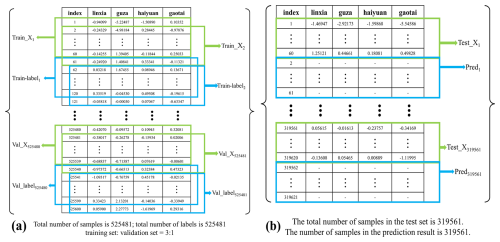
Figure 7Plot of data sliced to form samples and labels. (a) Data plot of samples and labels obtained from slicing the training dataset. The green box represents generated sample data; the blue box represents generated label data. (b) Data graph of sample data and predicted result shapes based on test dataset slices. The green box represents sample data; the blue box represents the predicted result shape.
The GWN model was divided into two modules: a 1D gated TCN and a GCN. In this process, the convolution kernel size was set to 2, and the expansion factor grew exponentially in powers of 2. As the number of convolution layers increased and the expansion factor grew exponentially, the receptive field of each unit expanded. With the sequence length defined as 60, the number of convolutional layers was set to six. The gated TCN, incorporating dilation causal convolution, captured longer-time-series features with fewer convolutional layers. Additionally, a discard rate was applied to the GCN convolution process to control model overfitting. The optimal hyperparameters of the VMD–GWN model are listed in Table 2.
5.2 Prediction results
The training data and neighbor matrix were used after preprocessing to train the GWN neural network model, and the validation data and neighbor matrix were used to evaluate the trained model, select the optimal model based on the evaluation results, and place the test data and neighbor matrix into the optimal model to perform the prediction. According to the prediction results, the data of each time step were compared; the maximum value of each time step was taken as the upper bound of the prediction interval, the minimum value was taken as the lower bound of the prediction interval, and the prediction interval was constructed according to the upper and lower bounds. Raw data and prediction intervals were analyzed to determine abnormal results. As shown in Fig. 8, the details of the prediction intervals and raw data of Linxia Station are given.
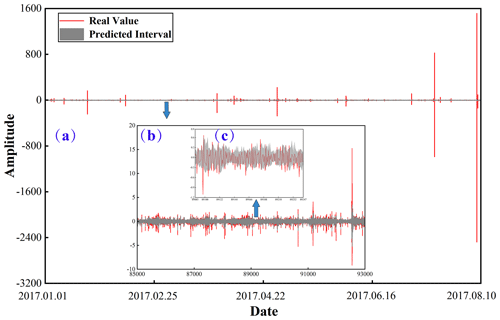
Figure 8Detailed plot of prediction results of VMD–GWN model at Linxia Station with raw data. The red lines are raw data after preprocessing, and the grey areas are prediction intervals. (a) Comparison plot of raw data and prediction intervals at Linxia Station. (b, c) Detailed plots of raw data versus predicted intervals. The date format is yyyy.mm.dd.
In Fig. 8a, it can be seen that the prediction results are relatively smooth at certain peak and trough positions. In Fig. 8b, the prediction results are provided in detail and show that the prediction intervals exhibit a trend that is similar to the true values, particularly for some peak and valley values of the true data. In Fig. 8c, most of the true values are wrapped within the prediction intervals, whereas the values outside the prediction intervals are defined as anomalies by defining their corresponding points as anomalies.
5.3 Abnormal extraction
For the extracted anomalies, it is difficult to judge the anomalous days before and after the onset of the earthquake; thus, we provide the judgment criteria for the anomalous days: (a) there must be more than 15 points outside the interval in a 30 min period and (b) the difference between the centroid of the predicted interval and the actual value must be greater than 1.5 times the bandwidth of the interval, and there must be more than 3 such points in that 30 min period. Days that satisfied the above conditions were defined as anomalous days (Chi et al., 2023).
Bufe and Varnes (1993) and Bufe et al. (1994) found that the clustering of intermediate events prior to a large shock leads to a regional increase in the cumulative Benioff strain ε(t), which can be fitted by a power-law time–destruction relationship:
where A and B are constants; is a constant for adjusting the power law; and tf is the predicted time of the mainshock, i.e., the critical point in time for the acceleration process of the cumulative Benioff strain (cumulative energy). This behavior has been interpreted as a critical process preceding the movement of a large earthquake towards a critical point (i.e., the mainshock). Bufe and Varnes (1993) justify Eq. (10) with a simple model of damage mechanics. De Santis (2014) studied the 2009 L'Aquila and 2012 Emilia earthquakes based on seismic catalogues, showing concretely how this accumulation of energy in space and time manifests. The research idea of this paper is the extraction of multi-station pre-earthquake anomalies based on spatio-temporal features, and the fitting method proposed above has good results in spatio-temporal terms. Additionally, this fitting method has theoretical support and physical significance, so for the anomalous results in our original paper, we use the S-type function to do the fitting. De Santis et al. (2017) used Swarm magnetosatellite data to study the 2015 Nepal earthquake and proposed an S-shape fitting function in anomalous cumulative analysis; they found that S-shape fitting was significantly superior to linear fitting. In this case, we studied the number of anomalous-day accumulations 2 months before and 3 d after the earthquake and fitted the number of anomalous-day accumulations with the S-shape function; the results of the S-shape function fitting for the four stations are shown in Fig. 9. We constructed the horizontal coordinates centered on the date of the Jiuzhaigou earthquake, where the negative sign indicates the number of days before the earthquake, the number of days after the earthquake are indicated by values without a negative sign, and EQ indicates the date of the earthquake (8 August 2017) in the center.
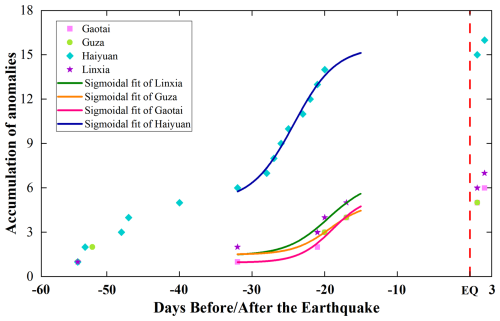
Figure 9Fitting results of cumulative number of anomalous days for four stations. The dashed red line represents the time of the earthquake; different marker shapes indicate anomalous days at stations; curves of different colors represent the results of the S-shape fit of anomalous accumulation by station.
Through an analysis of the results of the accumulation of anomalous days 2 months before and 3 d after the earthquake, we reached the following conclusions.
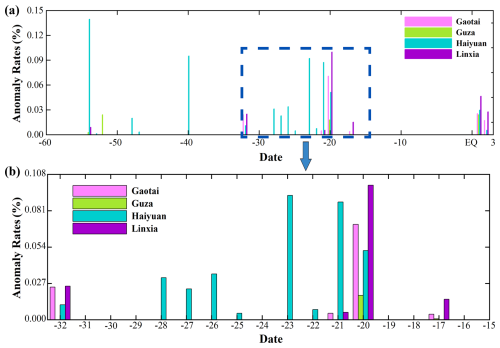
Figure 10Daily anomaly rate statistics for four stations. Differently colored bars represent the daily anomaly rates of different stations (a) Daily anomaly rate statistics from 60 d before to 3 d after the earthquake. (b) Daily anomaly rate statistics from 32 d before the earthquake to 15 d before the earthquake.
The number of anomalous days began to gradually increase from 7 July, and after continuing for 14 d until 24 July (15 d before the earthquake), a brief 15 d pre-earthquake quiet period occurred. Zhong et al. (2020) studied thermal infrared (TIR) data before the Jiuzhaigou earthquake and found that there was a significant increase in TIR anomalies from 3 to 24 July, which coincided almost exactly with our study period. Notably, we found that for all four stations in our study, the number of anomalous days increased simultaneously, and the S-function fitting results showed significantly accelerated anomalies. In order to verify the possibility that we extracted anomalies at all of our multiple stations, we analyzed the results of other studies using other data. Xu and Li (2020) used seismic observation records from 31 stations and found that the peaks occurred from 11 to 21 July prior to the earthquake and that the high values at the 31 stations were congruent. Xu et al. (2024) used broadband seismometer data from 10 stations near the epicenter to calculate the alignment entropy of the ground motion velocity and found that the entropy decreases were observed at all stations from 14 to 22 July. Therefore, we believe that the simultaneous occurrences of anomalies at the selected stations were not coincidental. For abnormal days, we only judge whether they are abnormal and do not know the specific number of anomalies. Therefore, we made a count of the judgment results that met the conditions for each abnormal day, and we took the statistical result as the number of abnormalities per day and calculated the abnormal rate per day based on the number of abnormalities per day. The statistical results of the abnormal rate per day are shown in Fig. 10.
As shown in Fig. 10a, in the time range from 60 d before the earthquake to 33 d before the earthquake, all four stations showed only a very small number of anomalies; at 32 d before the earthquake, anomalies appeared at a number of stations and the anomalies also increased significantly, with Haiyuan Station showing the most significant number of anomalies. The dashed box in Fig. 10a corresponds to the time period from 32 d before the earthquake to 15 d before the earthquake, and a detailed view of this period is shown in Fig. 10b. We find that there are several stations with anomalies at the same time at 32, 21, 20, and 17 d before the earthquake, among which all four stations have anomalies on the 20th day before the earthquake, and from the value of the anomaly rate, the anomaly rate on the 17th day before the earthquake has a very obvious decrease, so we believe that a turning point occurs on the 20th day before the earthquake, which corresponds to the time when the accelerating effect of the S-shape fitting is the most obvious. After the 17th day before the earthquake, there was a quiet period when no station detected anomalies until the earthquake occurred. The combined analysis of Figs. 9 and 10 gives a fuller picture of the process of pre-seismic anomalous changes.
Zhang et al. (2018) analyzed the temporal and spatial evolution characteristics of the precursor anomalies of the Jiuzhaigou earthquake and found that the short-term phases of the precursor anomalies of the Jiuzhaigou earthquake are divided into two phases, γ1 and γ2, among which the anomalies in the γ2 phase are deformation anomalies, which are manifested as the expansion of anomalies from the near-source area to outside of the epicenter. Wang et al. (1984) found that the extension of precursor anomalies to the periphery of the epicenter was due to the subcritical extension of cracks, and they justified their conclusions based on the inversion results of the precursor observations of resistivity. Guo et al. (2020) analyzed the deformation process in the unstable state of a fault and defined the meta-stable (or sub-stable) state of a fault as the transition stage from peak stress to fast destabilizing critical stress throughout the slow loading and fast unloading. At this stage, the accumulated strain energy starts to be released. Based on the conclusion of Yu et al. (2019), we believe that the anomalies extracted from multiple stations at the same time were involved in the final stage of the formation of the Jiuzhaigou earthquake, starting in July 2017, when the anomalies in the epicenter area gradually decreased and began to diffuse to the periphery and the stresses in the diffusion area of the epicenter were in a stage of cumulative enhancement. The anomalies received from our four stations came from the accumulation of strain energy during the diffusion process and eventually, due to the accumulation of strain energy exceeding the medium-strength limit, led to the occurrence of the Jiuzhaigou earthquake.
In this study, we employed a VMD–GWN method to study the anomalies of multi-station borehole strain data prior to the Jiuzhaigou earthquake. The influence of annual trends and tides on the borehole observation data was removed using VMD. The GWN model predicted the smooth data from each station in 2017, and anomalies were extracted by comparing the prediction results with the original data. Anomalous days were defined, and their cumulative results were fitted using an S-shape function. Analysis showed that 15 to 32 d before the earthquake, the number of anomalous days increased at all stations, with the most significant acceleration observed 20 d prior to the earthquake. An increase in anomalous days was also noted 1 to 3 d after the earthquake. We believe the pre-earthquake anomalies are due to the diffusion of strain energy in the epicentral region, indicating proseismic anomalies, while post-earthquake anomalies result from aftershocks. Given the complexity of and variability in earthquakes, further research is needed to refine the extraction and identification of pre-seismic borehole strain anomalies.
The data that support the findings of this study are available from the China Earthquake Networks Center, but restrictions apply to the availability of these data, which were used under license for the current study and are not publicly available. Data are however available from the corresponding author (email: 575104711@qq.com) upon reasonable request and with permission of the China Earthquake Networks Center.
Conceptualization: CL and CC; data curation: CL, CC, and CQ; formal analysis: CL, CC, and JZ; investigation: CL, CC, and YD; methodology: CC; resources: CC; software: CL and CQ; supervision: CC; validation: CL and CC; writing – original draft: CC and CL; writing – review and editing: CL and CC.
The contact author has declared that none of the authors has any competing interests.
Publisher's note: Copernicus Publications remains neutral with regard to jurisdictional claims made in the text, published maps, institutional affiliations, or any other geographical representation in this paper. While Copernicus Publications makes every effort to include appropriate place names, the final responsibility lies with the authors.
The authors would like to thank Zehua Qiu, Lei Tang, and Dehe Yang from the China Earthquake Administration for giving essential help in accessing their website (https://data.earthquake.cn, last access: 13 January 2025) and downloading the strain data. The authors are also grateful to the China Earthquake Networks Center for borehole strain data.
This research has been supported by the Natural Science Foundation of Hainan Province (grant no. 622RC669). This work is supported by the specific research fund of the Innovation Platform for Academicians of Hainan Province.
This paper was edited by Filippos Vallianatos and reviewed by two anonymous referees.
Abu Bakar, M. A., Mohd Ariff, N., Abu Bakar, S., Goh, P. C., and Rajendran, R.: Peramalan Kualiti Udara menggunakan Kaedah Pembelajaran Mendalam Rangkaian Perlingkaran Temporal (TCN), Sains Malays., 51, 3785–3793, https://doi.org/10.17576/jsm-2022-5111-22, 2021.
Akhoondzadeh, M., De Santis, A., Marchetti, D., and Shen, X.: Swarm-TEC Satellite Measurements as a Potential Earthquake Precursor Together With Other Swarm and CSES Data: The Case of Mw 7.6 2019 Papua New Guinea Seismic Event, Front. Earth Sci., 10, 820189, https://doi.org/10.3389/feart.2022.820189, 2022.
Bai, S., Kolter, J. Z., and Koltun, V.: An empirical evaluation of generic convolutional and recurrent networks for sequence modeling, arXiv [preprint], https://doi.org/10.48550/arXiv.1803.01271, 2018.
Barino, F. O., Silva, V. N. H., Lopez-Barbero, A. P., De Mello Honorio, L., and Santos, A. B. D.: Correlated Time-Series in Multi-Day-Ahead Streamflow Forecasting Using Convolutional Networks, IEEE Access, 8, 215748–215757, https://doi.org/10.1109/access.2020.3040942, 2020.
Bilal, M. A., Ji, Y., Wang, Y., Akhter, M. P., and Yaqub, M.: Early Earthquake Detection Using Batch Normalization Graph Convolutional Neural Network (BNGCNN), Appl. Sci.-Basel, 12, 7548, https://doi.org/10.3390/app12157548, 2022.
Bufe, C. G. and Varnes, D. J.: Predictive Modeling of the Seismic Cycle of the Greater San-Francisco Bay-Region, J. Geophys. Res.-Sol. Ea., 98, 9871–9883, https://doi.org/10.1029/93JB00357, 1993.
Bufe, C. G., Nishenko, S. P., and Varnes, D. J.: Seismicity Trends and Potential for Large Earthquakes in the Alaska-Aleutian Region, Pure Appl. Geophys., 142, 83–99, https://doi.org/10.1007/BF00875969, 1994.
Chen, L., Yan, X., Su, X., Jiang, Z., Wang, Z., and Hu, Y.: The Coseismic Comparative Analysis of Gaotai YRY Borehole Strain Gauge and BBVS-120 Seismometer of Maduo Ms 7.4 Earthquake in Qinghai, Journal of Geodesy and Geodynamics, 44, 539–544, https://doi.org/10.14075/j.jgg.2023.08.172, 2024.
Chen, Y., Shu, T., Zhou, X. K., Zheng, X. Z., Kawai, A., Fueda, K., Yan, Z., Liang, W., and Wang, K. I. K.: Graph Attention Network With Spatial-Temporal Clustering for Traffic Flow Forecasting in Intelligent Transportation System, IEEE T. Intell. Transp., 24, 8727–8737, https://doi.org/10.1109/TITS.2022.3208952, 2023.
Chi, C., Zhu, K., Yu, Z., Fan, M., Li, K., and Sun, H.: Detecting Earthquake-Related Borehole Strain Data Anomalies With Variational Mode Decomposition and Principal Component Analysis: A Case Study of the Wenchuan Earthquake, IEEE Access, 7, 157997–158006, https://doi.org/10.1109/access.2019.2950011, 2019.
Chi, C., Li, C., Han, Y., Yu, Z., Li, X., and Zhang, D.: Pre-earthquake anomaly extraction from borehole strain data based on machine learning, Sci. Rep.-UK, 13, 20095, https://doi.org/10.1038/s41598-023-47387-z, 2023.
Chi, S.: Strain Anomalies Before Wenchuan and Lushan Earthquakes Recorded by Component Borehole Strainmeter, Science and Technology Review, 31, 27–30, https://doi.org/10.3981/j.issn.1000-7857.2013.12.004, 2013.
Dauphin, Y. N., Fan, A., Auli, M., and Grangier, D.: Language modeling with gated convolutional networks, International conference on machine learning, Sydney, Australia, 933–941, arXiv [preprint], https://doi.org/10.48550/arXiv.1612.08083, 2017.
Deng, G., Liang, F., Li, X., Zhao, J., Liu, H., and Wang, X.: S-transform spectrum decomposition technique in the application of the extraction of weak seismic signals, Chinese J. Geophys.-Ch., 58, 4594–4604, 2015.
De Santis, A.: Geosystemics, Entropy and Criticality of Earthquakes: A Vision of Our Planet and a Key of Access, Nonlinear Phenomena in Complex Systems: From Nano to Macro Scale, WOS: 000345122100001, Springer, https://doi.org/10.1007/978-94-017-8704-8_1, 2014.
De Santis, A., Balasis, G., Pavón-Carrasco, F. J., Cianchini, G., and Mandea, M.: Potential earthquake precursory pattern from space: The 2015 Nepal event as seen by magnetic Swarm satellites, Earth Planet. Sc. Lett., 461, 119–126, https://doi.org/10.1016/j.epsl.2016.12.037, 2017.
Dobrovolsky, I. P., Zubkov, S. I., and Miachkin, V. I.: Estimation of the size of earthquake preparation zones, Pure Appl. Geophys., 117, 1025–1044, https://doi.org/10.1007/BF00876083, 1979.
Dragomiretskiy, K. and Zosso, D.: Variational Mode Decomposition, IEEE T. Signal Proces., 62, 531–544, https://doi.org/10.1109/tsp.2013.2288675, 2014.
Gan, Z., Li, C., Zhou, J., and Tang, G.: Temporal convolutional networks interval prediction model for wind speed forecasting, Electr. Pow. Syst. Res., 191, 106865, https://doi.org/10.1016/j.epsr.2020.106865, 2021.
Gopali, S., Abri, F., Siami-Namini, S., and Namin, A. S.: A Comparison of TCN and LSTM Models in Detecting Anomalies in Time Series Data, in: 2021 IEEE International Conference on Big Data (Big Data), Electr. Network, 15–18 December 2021, Orlando, FL, USA, 2415–2420, https://doi.org/10.1109/BigData52589.2021.9671488, 2021.
Guo, Y., Zhuo, Y., Liu, P., Chen, S., and Ma, J.: Experimental Study of Observable Deformation Process in Fault Meta-Instability State before Earthquake Generation, Geodynamics and Tectonophysics, 11, 417–430, https://doi.org/10.5800/gt-2020-11-2-0483, 2020.
Hafeez, A., Ehsan, M., Abbas, A., Shah, M., and Shahzad, R.: Machine learning-based thermal anomalies detection from MODIS LST associated with the Mw 7.7 Awaran, Pakistan earthquake, Nat. Hazards, 111, 2097–2115, https://doi.org/10.1007/s11069-021-05131-8, 2022.
Kipf, T. N. and Welling, M.: Semi-supervised classification with graph convolutional networks, arXiv [preprint], https://doi.org/10.48550/arXiv.1609.02907, 2016.
Kirisci, M. and Cagcag Yolcu, O.: A New CNN-Based Model for Financial Time Series: TAIEX and FTSE Stocks Forecasting, Neural Process. Lett., 54, 3357–3374, https://doi.org/10.1007/s11063-022-10767-z, 2022.
Kitagawa, Y., Koizumi, N., Takahashi, M., Matsumoto, N., and Sato, T.: Changes in groundwater levels or pressures associated with the 2004 earthquake off the west coast of northern Sumatra (M 9.0), Earth Planets Space, 58, 173–179, https://doi.org/10.1186/BF03353375, 2006.
Lei, Q., Zhai, S., Mao, Y., and Zhu, Z.: Analysis and research on baicheng Ms 5.4 earthquake based on Hilbert-Huang transform, Inland Earthquake, 36, 265–272, https://doi.org/10.16256/j.issn.1001-8956.2022.03.009, 2022.
Li, F., Zhang, B., Verma, S., and Marfurt, K. J.: Seismic signal denoising using thresholded variational mode decomposition, Explor. Geophys., 49, 450–461, https://doi.org/10.1071/eg17004, 2018.
Li, X., Ren, X., Lou, Y., Gao, S., Ge, X., and Liao, X.: An SG-ClM model mapping technology study via knowledge graph and graph attention network, Science and Technology Review, 41, 124–132, 2023.
Liang, A.: Research on Social Network Node Classification Based on Graph Neural Networks, Master's degree, Chongqing University of Technology, China, https://doi.org/10.27753/d.cnki.gcqgx.2023.001129, 2023.
Lin, J.-W.: An adaptive Butterworth spectral-based graph neural network for detecting ionospheric total electron content precursor prior to the Wenchuan earthquake on 12 May 2008, Geocarto Int., 37, 14292–14308, https://doi.org/10.1080/10106049.2022.2087752, 2022.
Liu, C., Wang, G., Shi, Z., and Zhao, D.: Groundwater precursor anomalies of the 7.0 Sichuan Lushan earthquake, in: Proceedings of the 2014 China Geoscience Joint Annual Conference-Topic 10: Fluid geoscience and the genesis of mega-mineralised zones and major natural disasters, 20–23 October 2014, Beijing, China, 2014.
Liu, J.: Research On Seismic Precursor Anomaly Detection, Master's degree, Southeast University, China, https://doi.org/10.27014/d.cnki.gdnau.2021.002788, 2022.
Liu, X., Yang, J., Chen, C., Guan, Y., Chen, G., Zhao, W., and Hong, M.: The argumentation of properties of borehole system at Linxia station, China, Chinese J. Geophys.-Ch., 59, 3343–3353, https://doi.org/10.6038/cjg20160918, 2016a.
Liu, Y., Yang, G., Li, M., and Yin, H.: Variational mode decomposition denoising combined the detrended fluctuation analysis, Signal Process., 125, 349–364, https://doi.org/10.1016/j.sigpro.2016.02.011, 2016b.
Lou, J. and Tian, J.: Review on seismic strain-wave observation based on high-resolution borehole strainmeters, Prog. Geophys., 37, 51–58, https://doi.org/10.6038/pg2022FF0050, 2022.
Ma, D., Niu, A., Yuan, S., Wang, X., and Wang, L.: Analysis on the influence of short-term atmospheric pressure fluctuation on body strain data based on spectrum characteristics, Inland Earthquake, 25, 255–262, https://doi.org/10.16256/j.issn.1001-8956.2011.03.010, 2011.
Manero, J., Béjar, J., and Cortés, U.: “Dust in the Wind …”, Deep Learning Application to Wind Energy Time Series Forecasting, Energies, 12, 2385, https://doi.org/10.3390/en12122385, 2019.
Nishimura, T.: Triggering of volcanic eruptions by large earthquakes, Geophys. Res. Lett., 44, 7750–7756, https://doi.org/10.1002/2017GL074579, 2017.
Qiu, Z., Kan, B., and Tang, L.: Conversion and application of 4-component borehole strainmeter data, Earthquake, 29, 83–89, 2009.
Qiu, Z., Yang, G., Tang, L., Guo, Y., and Zhang, B.: Abnormal Strain Changes Prior to the M 7.0 Lushan Earthquake Observed by a Borehole Strainmeter at Guzan, Journal of Geodesy and Geodynamics, 35, 158–161 + 166, https://doi.org/10.14075/j.jgg.2015.01.036, 2015.
Rao, D., Huang, M., Shi, X., Yu, Z., and He, Z.: A Microseismic Signal Denoising Algorithm Combining VMD and Wavelet Threshold Denoising Optimized by BWOA, CMES-Comp. Model. Eng., 141, 187–217, https://doi.org/10.32604/cmes.2024.051402, 2024.
Shan, F., Li, F., Wang, Z., Ji, P., Wang, M., and Sun, H.: Deep Learning Social Network Access Control Model Based on User Preferences, CMES-Comp. Model. Eng., 140, 1029–1044, https://doi.org/10.32604/cmes.2024.047665, 2024.
Shi, W., Peng, Z., Huang, Y., Zhang, G., and Wang, C.: Retracted: An unsupervised anomaly detection approach for pre-seismic ionospheric total electron content, Meas. Sci. Technol., 34, 055101, https://doi.org/10.1088/1361-6501/acb453, 2023.
Shu, G. and Zhang, Z.: Precursor observation with RZB Capacitance Borehole Strainmeter and its practice in earthquake prediction, Bulletin of the Institute of Crustal Dynamics, 22–29, 1997.
Shu, X., Ding, W., Peng, Y., Wang, Z., Wu, J., and Li, M.: Monthly Streamflow Forecasting Using Convolutional Neural Network, Water Resour. Manag., 35, 5089–5104, https://doi.org/10.1007/s11269-021-02961-w, 2021.
Solís, E., Noboa, S., and Cuenca, E.: Financial Time Series Forecasting Applying Deep Learning Algorithms, Information and Communication Technologies, Univ Politecnica Salesiana, Guayaquil, Ecuador, 24–26 Nov 2021, 46–60, https://doi.org/10.1007/978-3-030-89941-7_4, 2021.
Tang, L., Fan, J., Liu, G., and Qiu, Z.: The Reliability Analysis of Strain Seismic Waves Recorded by High Sampling Four-component Borehole Strain Meter, Earthquake Research In China, 39, 78–87, 2023.
van den Ende, M. P. and Ampuero, J. P. J. G. R. L.: Automated seismic source characterization using deep graph neural networks, Geophys. Res. Lett., 47, e2020GL088690, https://doi.org/10.1029/2020GL088690, 2020.
Van Den Oord, A., Dieleman, S., Zen, H., Simonyan, K., Vinyals, O., Graves, A., Kalchbrenner, N., Senior, A., and Kavukcuoglu, K.: Wavenet: A generative model for raw audio, arXiv [preprint], https://doi.org/10.48550/arXiv.1609.03499, 2016.
Wang, X., Qi, G., and Zhao, Y.: Propagation before fault instability and resistivity precursor, Sci. Sinica, 11, 1026–1038, 1984.
Wu, L., Zhang, L., Li, G., and Guo, H.: The Relative Calibration and Its Application of 4-component Borehole Strain Observation in HaiYuan Station, Journal of Seismological Research, 33, 318–322, 2010.
Wu, Z., Pan, S., Long, G., Jiang, J., and Zhang, C.: Graph WaveNet for Deep Spatial-Temporal Graph Modeling, Proceedings of the Twenty-eighth International Joint Conference on Artificial Intelligence, 10–16 August 2019, Macao, Peoples Republic of China, 1907–1913, 2019.
Wu, Z., Pan, S., Chen, F., Long, G., Zhang, C., and Philip, S. Y.: A comprehensive survey on graph neural networks, IEEE T. Neur. Net. Lear., 32, 4–24, https://doi.org/10.1109/TNNLS.2020.2978386, 2020.
Xu, K. and Li, Y.: The violent ground motion before the Jiuzhaigou earthquake Ms 7.0, Open Geosci., 12, 919–927, https://doi.org/10.1515/geo-2020-0184, 2020.
Xu, K., Li, Y., Li, X., Wan, W., and Ju, H.: Seismological Characteristics of Seismogenic Process of the Jiuzhaigou Ms 7.0 Earthquake, Journal of Geodesy and Geodynamics, 44, 497–502, https://doi.org/10.14075/j.jgg.2023.08.154, 2024.
Xu, X., Chen, G., Wang, Q., Chen, L., Ren, Z., Xu, C., Wei, Z., Lu, R., Tan, X., Dong, S., and Shi, F.: Discussion on seismogenic structure of jiuzhaigou earthquake and its implication for current strain state in the southeastern Qinghai-Tibet Plateau, Chinese J. Geophys.-Ch., 60, 4018–4026, https://doi.org/10.6038/cjg20171028, 2017.
Yadav, A., Kumar, N., Verma, S. K., Shukla, V., and Chauhan, V.: Imprint of Diurnal and Semidiurnal Cyclicity in Radon Time Series of MPGO, Ghuttu Garhwal Himalaya: Evidence Based on Singular Spectrum Analysis, Pure Appl. Geophys., 180, 1081–1097, https://doi.org/10.1007/s00024-023-03231-z, 2023.
Yang, G., Liu, S., and Li, X.: A Report on Borehole Strain Observation at Guzan Station for the 8.0 Wenchuan Earthquake of 2008, Bulletin of the Institute of Crustal Dynamics, 135–148, 2010.
Yang, X., Liu, C., He, B., Dou, M., Wang, D., and Zhang, L.: Analyzing the anomaly of the extensional strain steps recorded by borehole dilatometer at Qianling Seismic Station, Seismological and Geomagnetic Observation and Research, 35, 159–164, 2014.
Yao, X., Wang, W., and Teng, Y.: Detection of Geomagnetic Signals as Precursors to Some Earthquakes in China, Appl. Sci.-Basel, 12, 1680, https://doi.org/10.3390/app12031680, 2022.
Yi, G., Long, F., Liang, M., Zhang, H., Zhao, M., Ye, Y., Zhang, Z., Qi, Y., Wang, S., Gong, Y., Qiao, H., Wang, Z., Qiu, G., and Su, J.: Focal mechanism solutions and seismogenic structure of the 8 August 2017 M 7.0 Jiuzhaigou earthquake and its aftershocks, northern Sichuan, Chinese J. Geophys.-Ch., 60, 4083–4097, https://doi.org/10.6038/cjg20171033, 2017.
Yin, H., Zhong, J., Li, R., Shang, J., Wang, C., and Li, X.: High-Order Neighbors Aware Representation Learning for Knowledge Graph Completion, IEEE T. Neur. Net. Lear., https://doi.org/10.1109/tnnls.2024.3383873, in press, 2024.
Yu, H., Yu, C., Ma, Z., Zhang, X., Zhang, H., Yao, Q., and Zhu, Q.: Temporal and Spatial Evolution of Load/Unload Response Ratio Before the M 7.0 Jiuzhaigou Earthquake of Aug. 8, 2017 in Sichuan Province, Pure Appl. Geophys., 177, 321–331, https://doi.org/10.1007/s00024-019-02101-x, 2019.
Yu, Z., Zhu, K., Hattori, K., Chi, C., Fan, M., and He, X.: Borehole Strain Observations Based on a State-Space Model and ApNe Analysis Associated With the 2013 Lushan Earthquake, IEEE Access, 9, 12167–12179, https://doi.org/10.1109/access.2021.3051614, 2021.
Yue, C., Niu, A., Yu, H., Ji, P., Jiang, X., Wang, Y., and Ma, W.: Evolutionary Characteristics of Ground Strain LURR Anomaly before Jiuzhaigou Ms 7.0 Earthquake, Earthquake Research In China, 36, 267–275, 2020.
Zhang, A. and Li, Y.: Analysis of Thermal Infrared Brightness Temperature Anomaly Characteristics Before Aksai Ms 5.5 Earthquake on August 26, 2021, Inland Earthquake, 37, 137–144, https://doi.org/10.16256/j.issn.1001-8956.2023.02.003, 2023.
Zhang, J. and He, X.: Earthquake magnitude prediction using a VMD-BP neural network model, Nat. Hazards, 117, 189–205, https://doi.org/10.1007/s11069-023-05856-8, 2023.
Zhang, L. and Niu, F.: Component borehole strain observations coupling coefficients calculation, Chinese J. Geophys.-Ch., 56, 3029–3037, https://doi.org/10.6038/cjg20130916, 2013.
Zhang, T.: Research on the Surface Deformation of Jiuzhaigou Earthquake Based on the Technology of D-InSAR, Scientific and Technological Innovation, Heilongjiang Association for Science and Technology, 14–17, https://kns.cnki.net/kcms2/article/abstract?v=uQDmaVEYwcx6 (last access: 15 November 2024), 2023.
Zhang, W.: Analysis of borehole strain earthquake precursory observation data based on Wavelet Transform, bachelor's degree, Jilin University, https://kns.cnki.net/kcms2/article/abstract?v=ZkvsKdWJ3SQc (last access: 15 November 2024), 2018.
Zhang, X., Song, Z., and Li, G.: Temporal and Spatial Evolution of Precursory Anomalies of the Jiuzhaigou Ms 7.0 Earthquake and its Analysis, Earthquake Research in China, 34, 772–780, 2018.
Zhang, X., Cao, L., Chen, Y., Jia, R., and Lu, X.: Microseismic signal denoising by combining variational mode decomposition with permutation entropy, Appl. Geophys., 19, 65–80, https://doi.org/10.1007/s11770-022-0926-6, 2022.
Zhong, M., Shan, X., Zhang, X., Qu, C., Guo, X., and Jiao, Z.: Thermal Infrared and Ionospheric Anomalies of the 2017 Mw 6.5 Jiuzhaigou Earthquake, Remote Sens.-Basel, 12, 2843, https://doi.org/10.3390/rs12172843, 2020.
Zhu, K., Chi, C., Yu, Z., Zhang, W., Fan, M., Li, K., and Zhang, Q.: Extracting borehole strain precursors associated with the Lushan earthquake through principal component analysis, Ann. Geophys., 61, SE447, https://doi.org/10.4401/ag-7633, 2018.
Zhu, K., Fan, M., He, X., Marchetti, D., Li, K., Yu, Z., Chi, C., Sun, H., and Cheng, Y.: Analysis of Swarm Satellite Magnetic Field Data Before the 2016 Ecuador (Mw=7.8) Earthquake Based on Non-negative Matrix Factorization, Front. Earth Sci., 9, 621976, https://doi.org/10.3389/feart.2021.621976, 2021.







